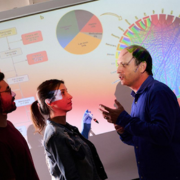TAU researcher sheds light on prehistoric recycling
Evidence suggests our prehistoric ancestors learned to recycle the objects they used in their daily lives
Contrary to the view that recycling is a modern invention, there is mounting evidence that suggests our prehistoric ancestors learned to recycle the objects they used in their daily lives.
At The Origins of Recycling Conference, recently held at Tel Aviv University, Prof. Ran Barkai said, "For the first time we are revealing the extent of this phenomenon, both in terms of the amount of recycling that went on and the different methods used." Prof. Barkai, an archaeologist from the Sonia and Marco Nadler Institute of Archeology, was one of the organizers of the four-day conference, with gathered over 50 researchers from 10 countries around the world.
According to Prof. Barkai, just as today we recycle materials such as paper and plastic to manufacture new items, early hominids would collect discarded or broken tools made of flint and bone to create new utensils.
This behavior appeared at different times, in different places, and with different methods, depending on the context and the availability of raw materials,
Recycling was widespread not only among early humans but among our evolutionary predecessors such as Homo erectus, Neanderthals and other species of hominids that have not yet even been named, according to Prof. Barkai.
Prof. Avi Gopher, a fellow TAU archeologist, said the early appearance of recycling highlights its role as a basic survival strategy. While they may not have been driven by concerns over pollution and the environment, hominids shared some of our motivations.
"Why do we recycle plastic? To conserve energy and raw materials," Prof. Gopher said. "In the same way, if you recycled flint you didn't have to go all the way to the quarry to get more, so you conserved your energy and saved on the material."
A recycling find
At Qesem cave, a site near Tel Aviv dating back to between 200,000 and 420,000 years ago, Prof. Gopher and Prof. Barkai discovered flint chips that had been reshaped into small blades to cut meat — an early version of cutlery.
Some 10 percent of the tools found at the site were recycled in some way, Prof. Gopher said. "It was not an occasional behavior; it was part of the way they did things, part of their way of life," he said.
He said scientists have various ways to determine if a tool was recycled. They can find direct evidence of retouching and reuse, or they can look at the object's patina — a progressive discoloration that occurs once stone is exposed to the elements. Differences in the patina indicate that a fresh layer of material was exposed hundreds or thousands of years after the tool's first incarnation.






